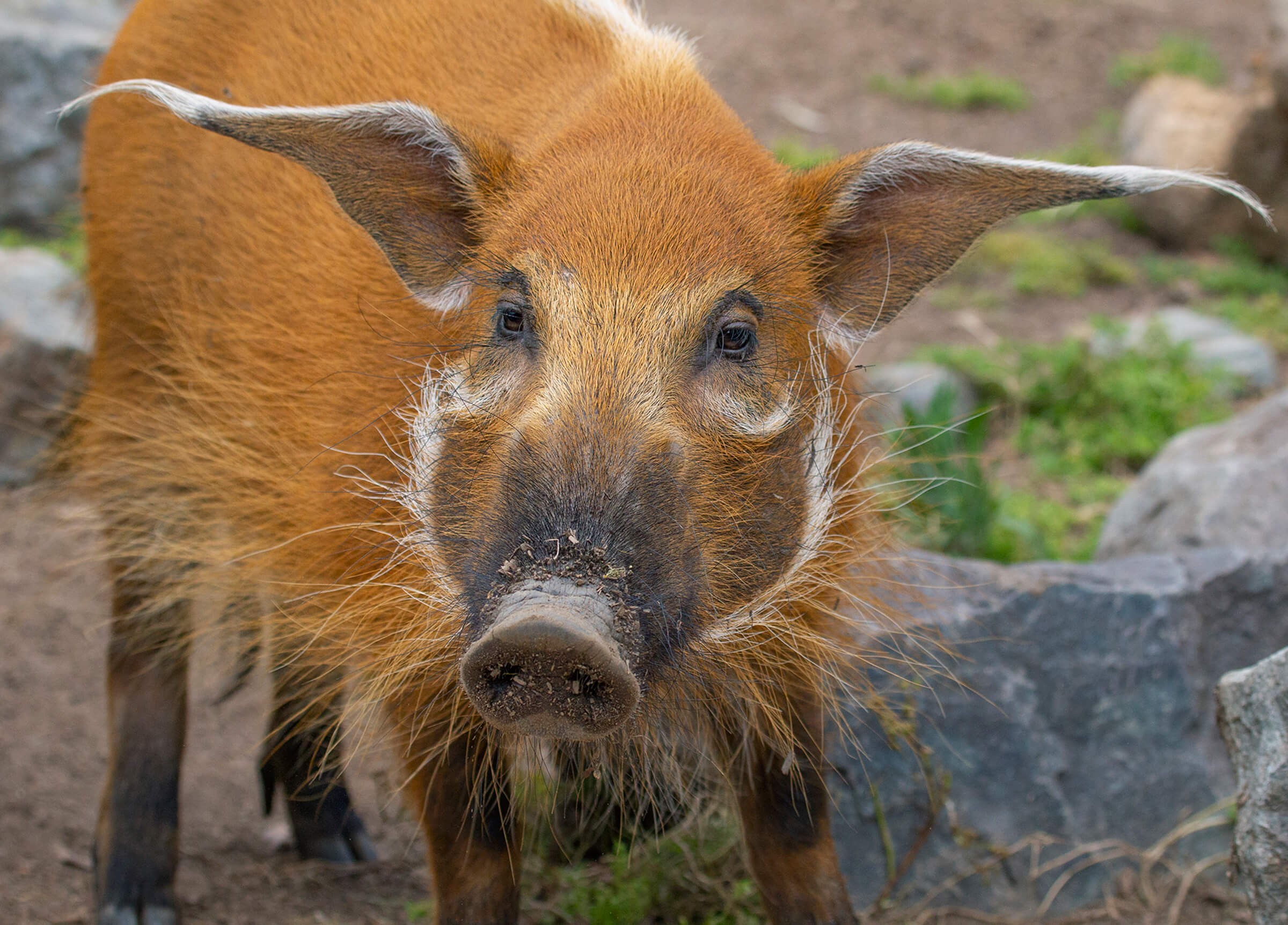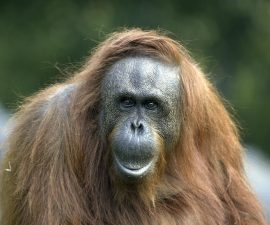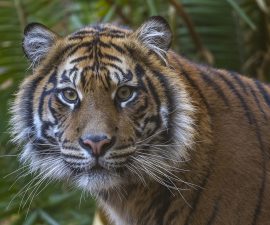BY Eston Ellis
Photography by Ken Bohn
February 5, 2019 marks the beginning of Lunar New Year, also known in China as the Spring Festival, and this year has been designated as the Year of the Pig. While most people think of just one domesticated farm animal when they hear the word “pig,” there are actually 18 species of wild swine in the family Suidae. At the San Diego Zoo and Safari Park, you’ll find Sulawesi babirusas, red river hogs, Visayan warty pigs, and southern warthogs, and there is even a domestic pig animal ambassador.
Domestic pigs are known for having curly tails, but wild swine do not have this characteristic. And while domestic pigs have been known to grow as large as 7.5 feet in length and weigh over 1,000 pounds, wild swine are smaller—ranging from around 2 feet in length and 21 pounds for a pygmy hog to as much as nearly 7 feet in length and around 600 pounds for a giant forest hog. Males (called boars) are always larger than females (called sows), and they have larger tusks, which they use in fighting off other males. Their lower tusks are sharp, and can reach three inches in length.
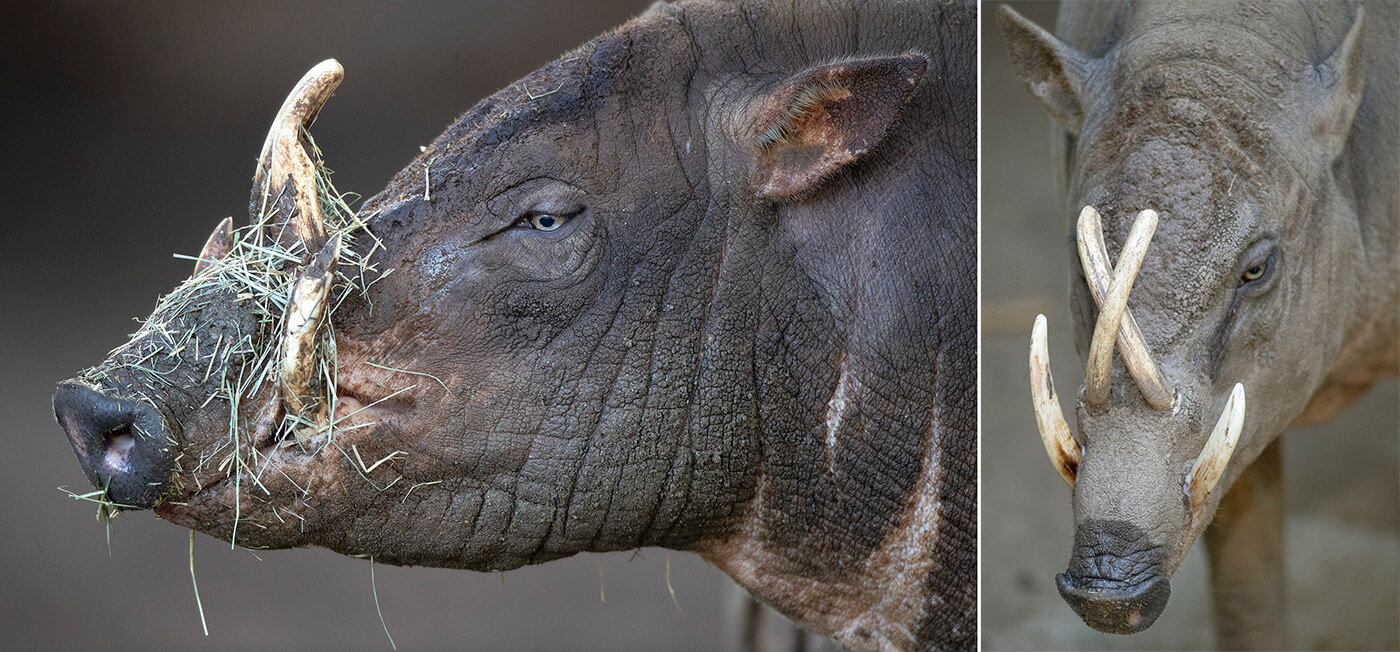
MULTI-TUSKING
Male babirusas have tusks on each side of their lower jaw and two more that grow right up through their upper snout, somewhat resembling horns or antlers.
You’ll find wild swine species in a variety of habitats, including rain forests (home to babirusas and red river hogs), forests (home to bush pigs and forest hogs), and savannas (home to warthogs). They all frequent mud wallows to cool off, and that mud also helps guard their skin against insect bites. Wild swine are usually nocturnal or crepuscular (active at dusk and dawn), resting during the day in burrows or flattened areas in tall vegetation.
Pigs are omnivores, with a varied diet that might include insects, roots, fruit, leaves or grass, small reptiles, mammals, and even carrion (already-dead animals). But while pigs may be best known for their voracious appetite and their love of wallowing in mud, they deserve more kudos for their intellect. Pigs are smart—and wild swine species including red river hogs and southern warthogs have been animal ambassadors at the Zoo and Safari Park for many years, some participating in educational presentations at the Zoo’s Wegeforth Bowl and the Park’s Benbough Amphitheater.
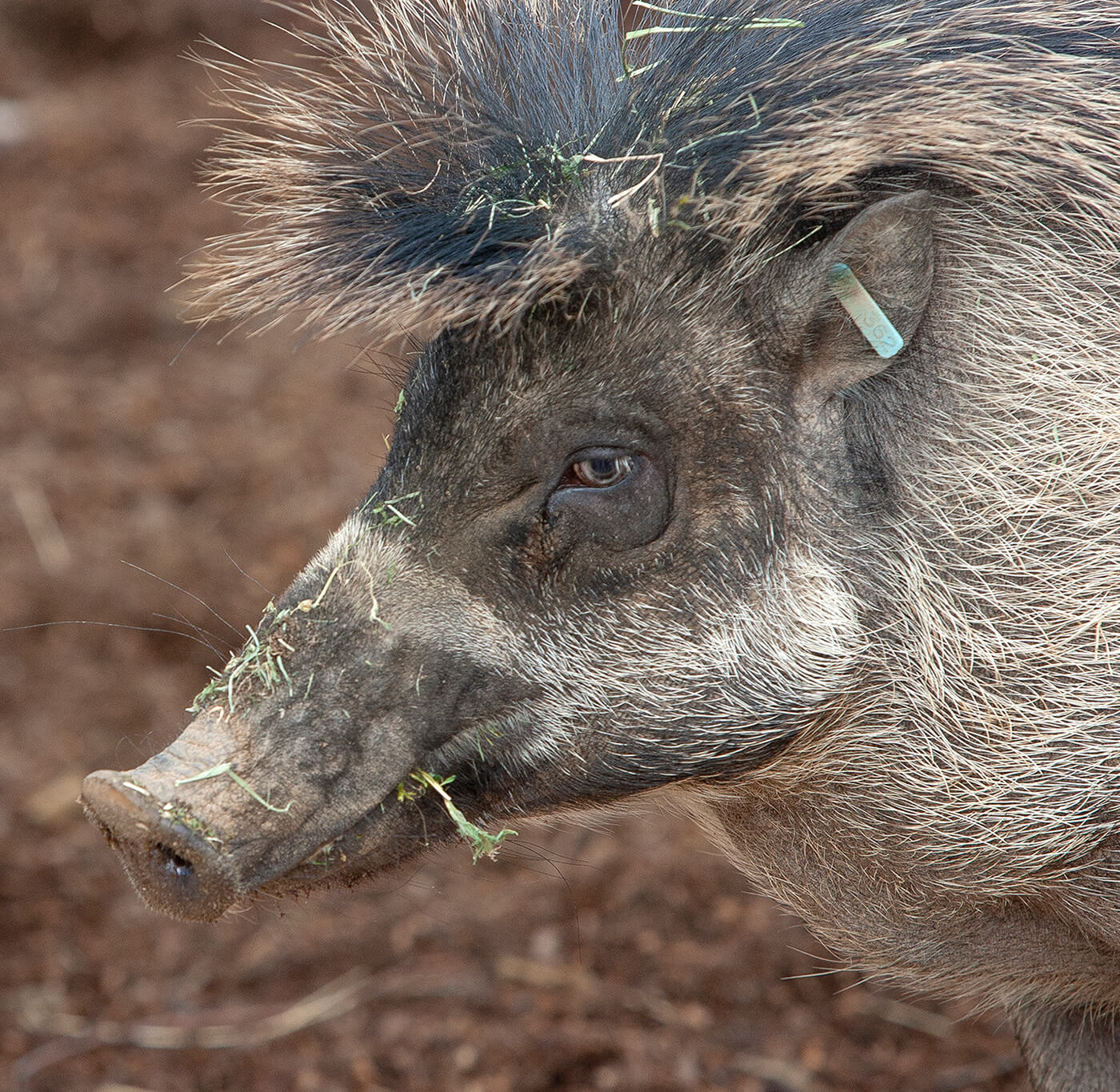
ENDANGERED SWINE
The San Diego Zoo was the first facility outside of the Visayan warty pig’s homeland in the Philippines to successfully breed this critically endangered species.
In the wild, these social animals usually live in a family group called a sounder, which includes adult females, their offspring, and an adult male. They are skilled communicators, using grunts, squeaks, chirrups, growls, and roars to keep in touch with the rest of their sounder or to warn others of danger. They also communicate with body language—raising the crest of hair on their back, cocking their ears, grinding their teeth, or jerking their head up or to the side—and by scent marking.
Wild swine have an extremely keen sense of smell. They also have remarkable hearing, and they are very resourceful in locating food—capable of using their tough snouts to detect and root up edible tubers that are buried nearly a foot underground. At the Safari Park, one wild swine animal ambassador is so versatile, he even appears in the bird show.
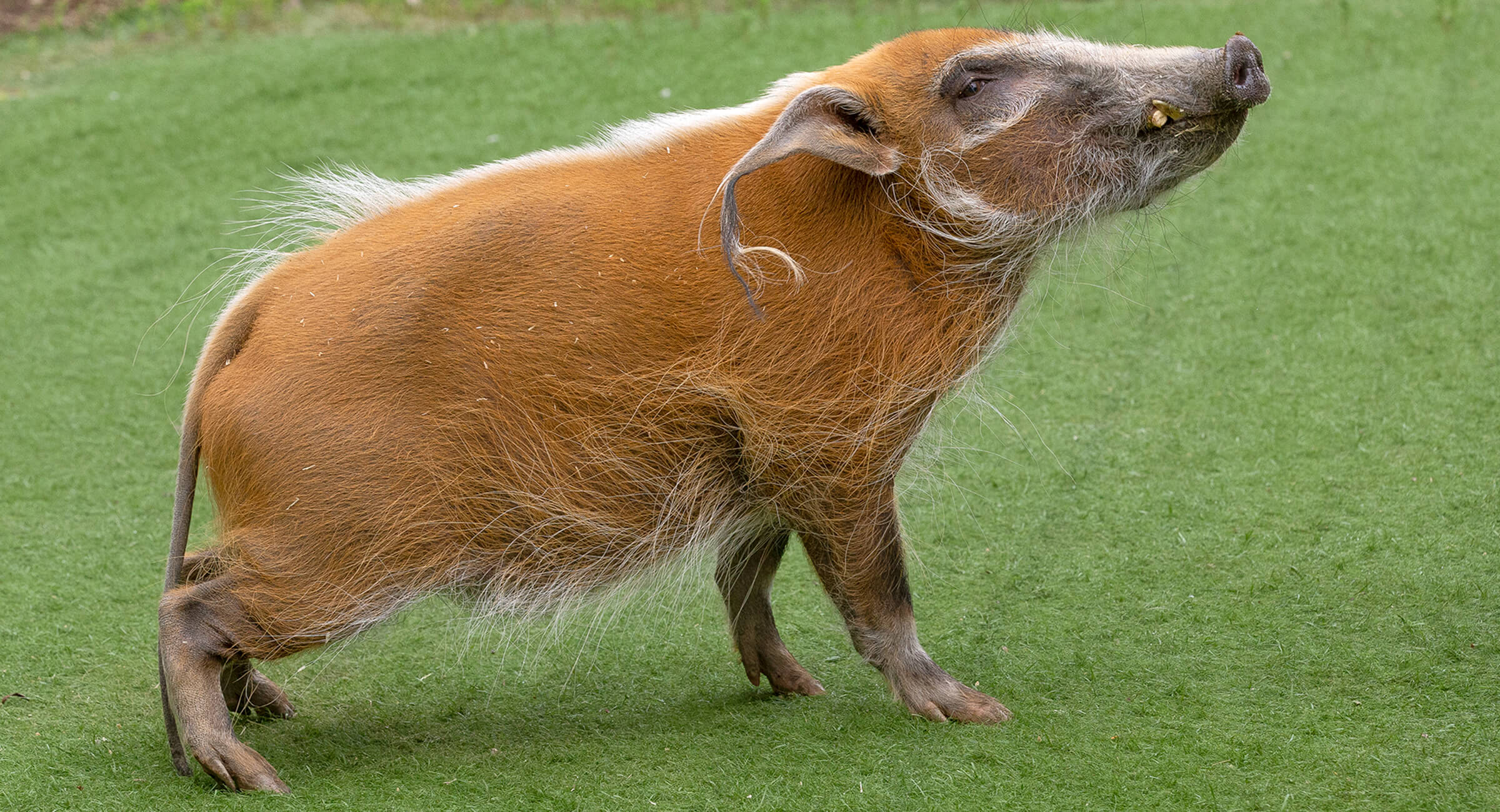
 Depending on the species, wild swine mothers may produce 2 to 14 piglets in a litter, although they sometimes give birth to a single piglet.
Depending on the species, wild swine mothers may produce 2 to 14 piglets in a litter, although they sometimes give birth to a single piglet.
Rooting for Rooty
Rooty, an 11-year-old red river hog at the Safari Park, has been a crowd favorite in the Frequent Flyers Bird Show at Benbough Amphitheater for more than a decade. Twice a day, on average, Rooty trots across the stage and provides the laughs between the spectacular aerial escapades of the Park’s animal ambassador birds. “When does a red river hog belong in a bird show? When pigs fly”—or so goes the long-running joke. But even if he can’t actually take flight, Rooty has flown right into the hearts of guests, and he has long been the star of the show, said Lacey Zeno, lead animal trainer.
“Rooty has more fans than any bird in our Frequent Flyers show,” Lacey said. “He is well loved. When he’s around, most of the kids just yell with delight. Everybody asks about the pig—and many people tell me they come to the bird show just to see Rooty!”
Red river hogs get their name from their reddish-brown color and for the fact that they generally live near rivers in Africa. In their native habitats, these wild swine use their ability to swim underwater (only having to come up for air every 15 seconds or so) to escape predators, including big cats such as leopards.
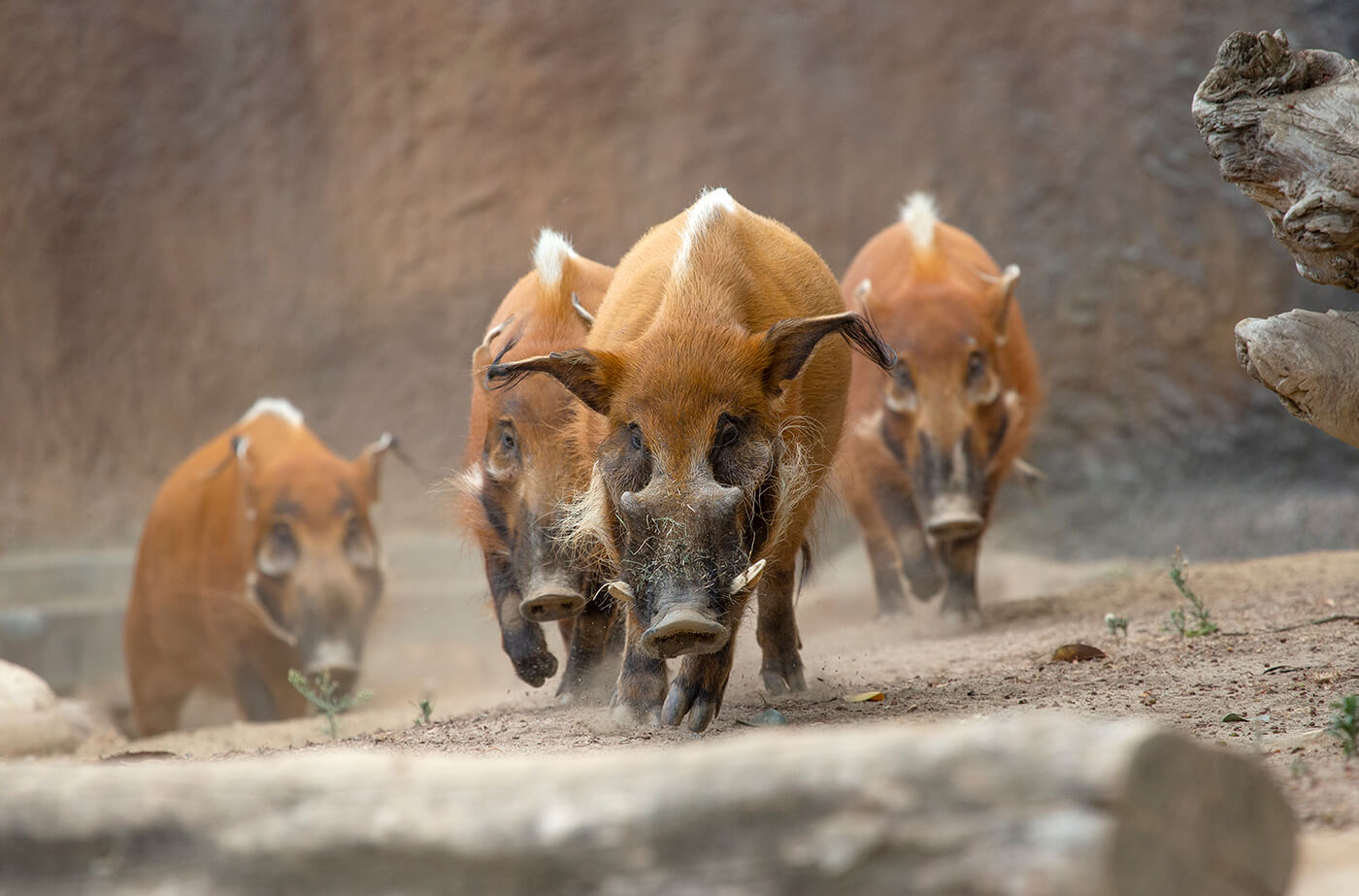
FAMILY LIFE
Wild swine live in family groups called sounders, typically consisting of a male, several females, and their offspring.
At the Safari Park, Rooty is better known for his antics on dry land. “Occasionally, we’ll put him in an animal encounter, where he shows off some of his trained behaviors: he lies down, sits, and can walk in a circle,” Lacey said. “People are just blown away by him. He’s so smart.”
While Rooty is always separated from guests by a barrier (such as the short fence around the stage at Benbough Amphitheater), when guests aren’t on grounds, Rooty is so well behaved that he is allowed to go on walks through the Park with his trainers, said trainer Stacey Stephens. “He walks past the gorillas of Gorilla Forest, and they look at him as if they’re saying, ‘is that really a red river hog out walking with those people?’ He likes to stare at the pelicans at Mombasa Lagoon, and he walks right by the lorikeets. He does get tired after a little while, but he is just super cool wherever he goes.”
Like other wild swine, red river hogs are omnivores—and Rooty is no exception. “He would probably eat just about anything we’d give him, but he does stick to a prescribed diet,” Lacey said. He gets hay every morning, and high-fiber herbivore pellets are dropped into his enclosure—in random locations and at random times—by an overhead auto feeder. That gives him the opportunity to search for food and root for it throughout his area, as he would in the wild.
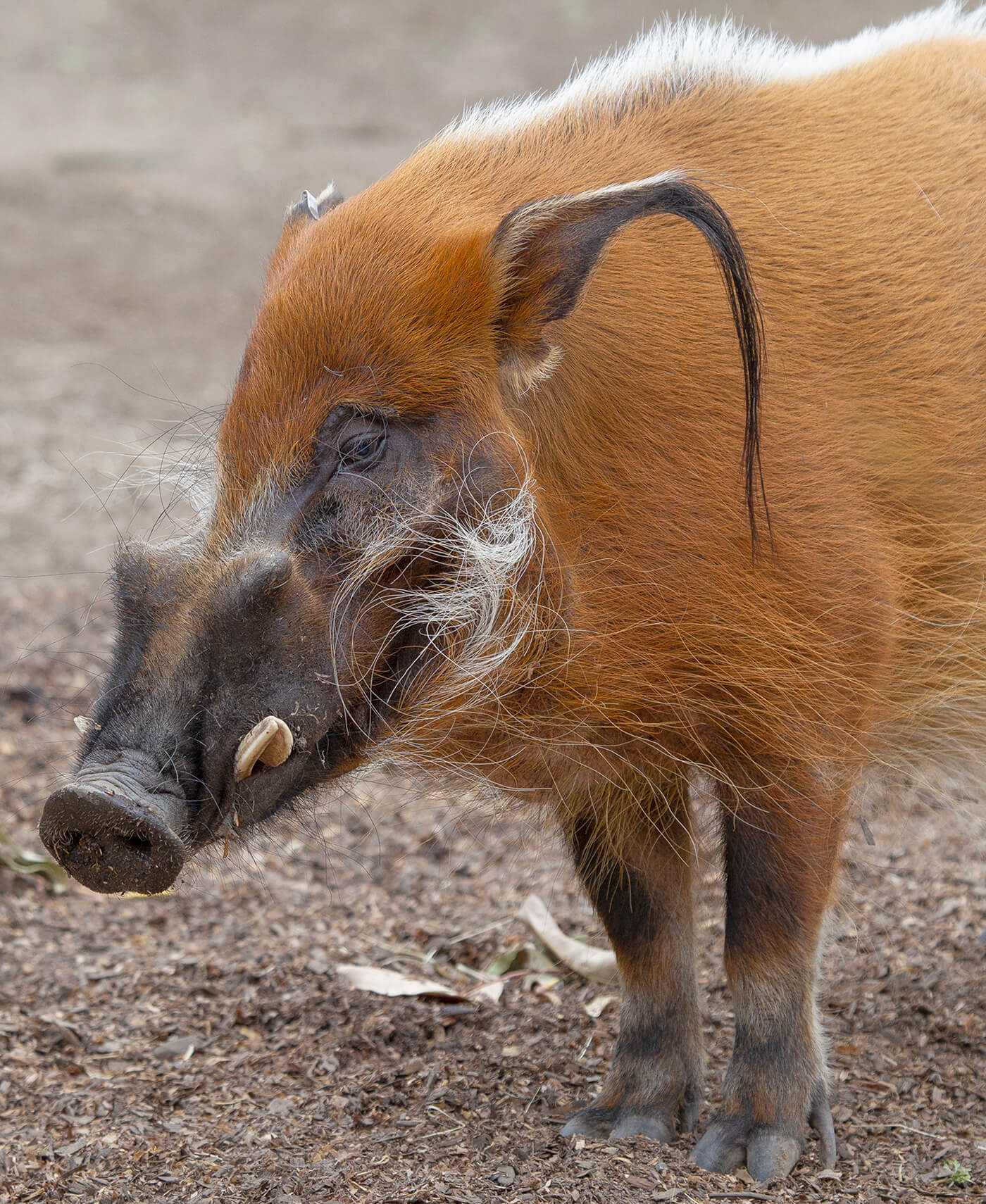
FLYAWAY HAIR
Red river hogs sometimes use the long tufts of hair that grow from their ears to shoo away flies, just as they brush flies away with their tail.
In Africa, red river hogs are foragers, and they use their tough snout to locate and dig out their next meal. “Rooty uses his nose a lot, sniffing for food—and with his strong snout, he can push, push, push,” Lacey said. “His nose is like his hand. He pushes with it, and he uses it a lot.” And his sense of smell is so sensitive, he is quick to detect something new in his area, such as a crate with a new smell—or if a cheetah has been out on the Benbough Amphitheater stage earlier in the day.
In addition to his regular diet, Rooty gets special treats that include apples, broccoli, and kale. “He seems to enjoy kale a lot—but I think he’s the only one,” Lacey said, laughing. “He could eat kale from morning till night, if we’d let him.”
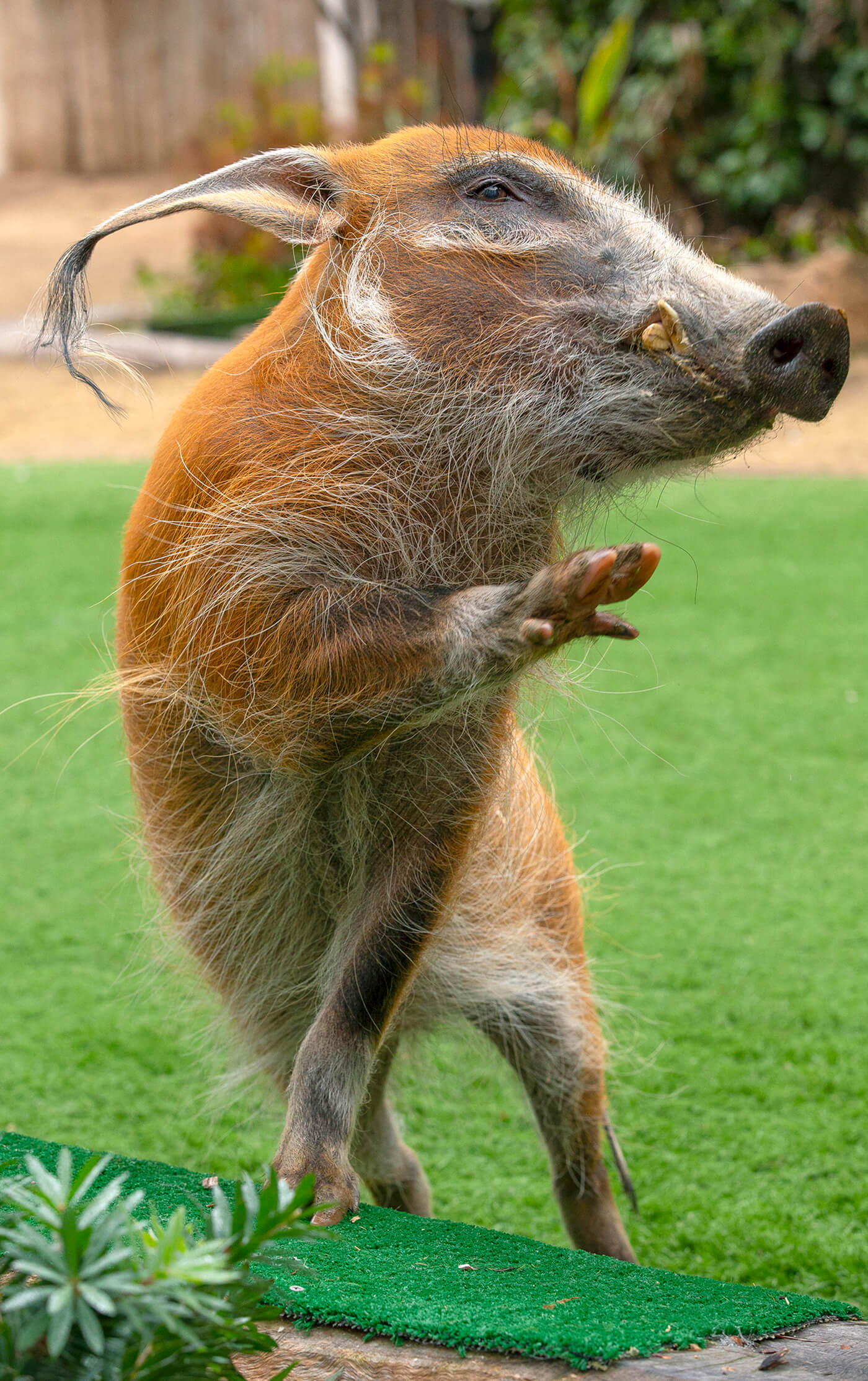
ATTENTION HOG
Animal ambassador Rooty has introduced many Safari Park guests to his red river hog species. In his regular appearances, he demonstrates just how smart wild swine can be.
What might surprise people about Rooty? “He can be fast when he wants to be,” Stacey said. “He can really run.” In addition, he can wiggle his ears in such a way that he uses the tufts of hair on his ears to shoo away flies, just as he uses his tail to brush them away.
Unlike most red river hogs, Rooty does not seem to enjoy getting dirty, and avoids mud whenever he can, Lacey said. “But the three female red river hogs that live with the okapis at the Safari Park do love to roll in the mud, wrestling and pushing each other around. They are very entertaining to watch.”
Guests can see red river hogs at the Zoo’s Hippo Trail and the Park’s African Woods, in addition to Rooty’s Frequent Flyers Bird Show performances at the Park’s Benbough Amphitheater, at noon and 2 p.m. daily.
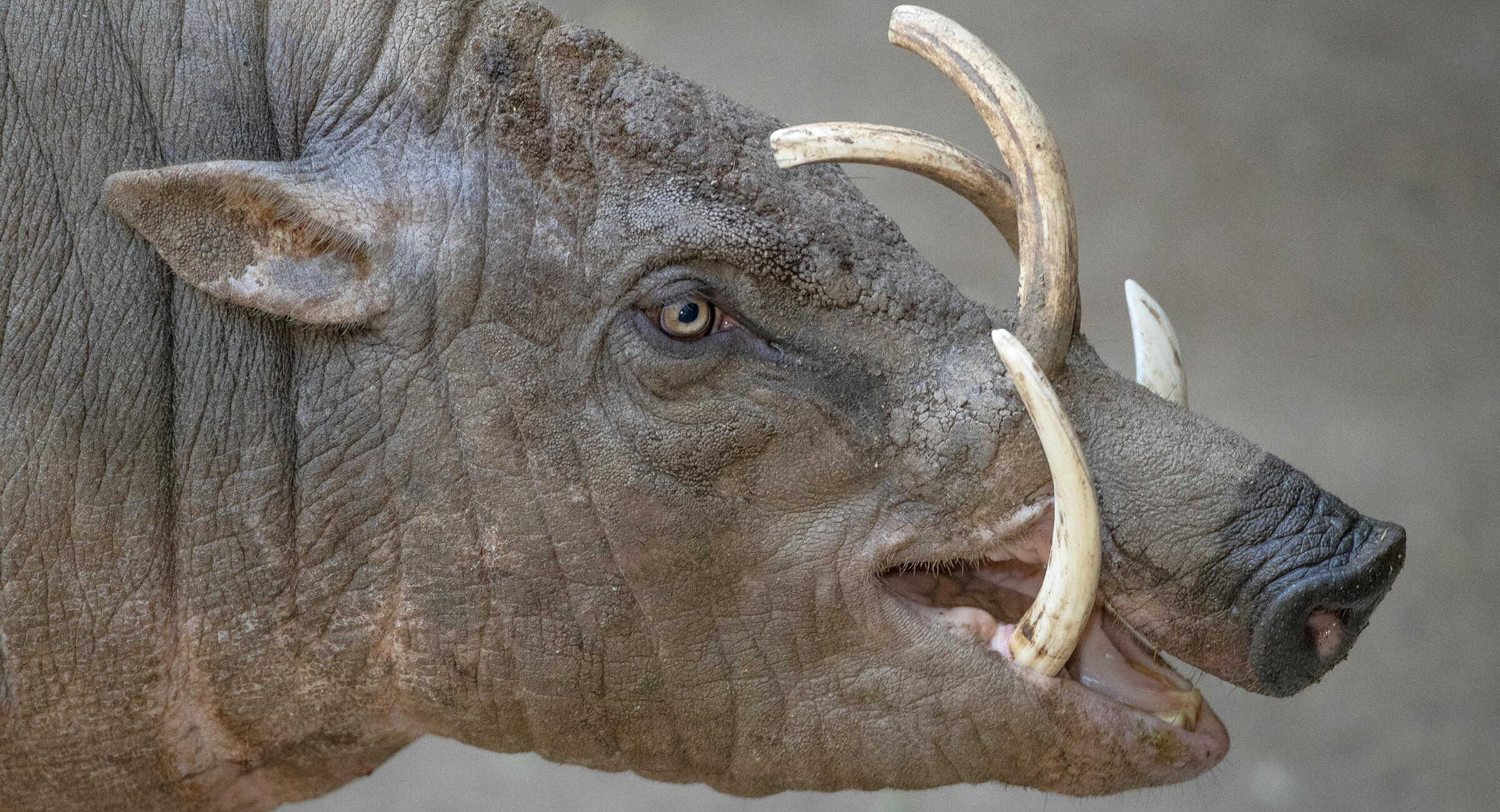
 Wild swine of most species are born with temporary, built-in camouflage that makes them look a bit like brown, striped watermelons with legs. However, babirusas, warthogs, and forest hogs are a solid color at birth.
Wild swine of most species are born with temporary, built-in camouflage that makes them look a bit like brown, striped watermelons with legs. However, babirusas, warthogs, and forest hogs are a solid color at birth.
Wild Tusks
Sulawesi babirusas, sometimes called “pig deer” in Indonesia, have unusual tusks that grow right up through the top of their mouth (instead of on the sides of their jaw) and curve backward on the top of the snout. Males use those tusks for fighting, locking an opponent’s tusks to stop attacks. These unique wild swine with deer-like legs and barrel-shaped bodies live in island rain forests.
Guests will find babirusas at both the Zoo and Safari Park; however, there have been some major changes recently—the biggest one being that brothers Homer and Jethro have traded places. Homer, for whatever reason, has not been successful at fathering babirusas at the Park, but Jethro has already fathered seven piglets at the Zoo—with adult babirusa females Fig and Mary-Kate, who is currently raising two piglets that were born December 16, 2018. Keepers hope the change of scenery will help Homer finally become a father at the Zoo, and they hope Jethro will help increase the population of babirusas at the Park. Currently, Zoo guests can see the three adults, along with Mary-Kate’s two new piglets, her daughter Cahaya, and Fig’s daughters Sula and Wesi, at their exhibit near Treetops Way on Tiger Trail.
“The exhibit just got a brand-new swimming pool,” said Victoria Girdler, senior keeper. “It’s three feet deep, so they can really swim now, instead of just getting wet. There’s also a motion sensor that activates a shower for 15 seconds if one of them passes by. These pigs are very smart—so if they like it, they will be able to figure out how to turn on the shower anytime they want it.”
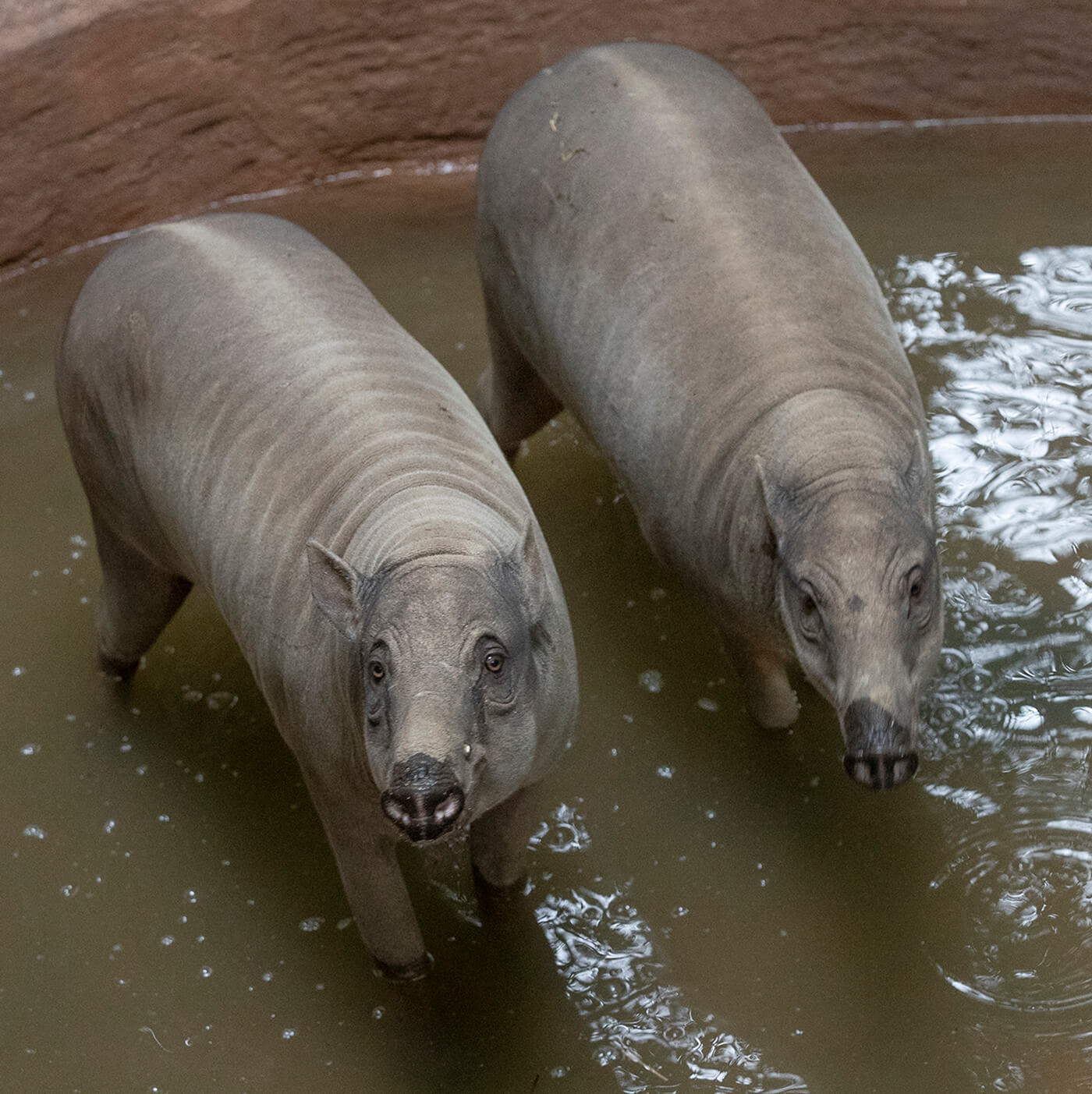
KEEPING COOL IN THE POOL
Babirusas at the Zoo recently got a new pool, with three-foot water depth for swimming and a motion-activated shower.
The babirusas already enjoy using a water hose in their exhibit as a water toy. “They love to play in the water hose—and they lick the water as it comes out, just like a little kid drinking out of a garden hose,” Victoria said.
Guests will notice many behaviors in the babirusas that are typical of wild swine species. “They have the typical swine snout, and they like to root with it,” Victoria said. “They also love mud to cool off in. When we put out a fresh dirt pile, as enrichment, we’ll see all of them rooting in it, rolling and playing in it—it turns into a mud party!”
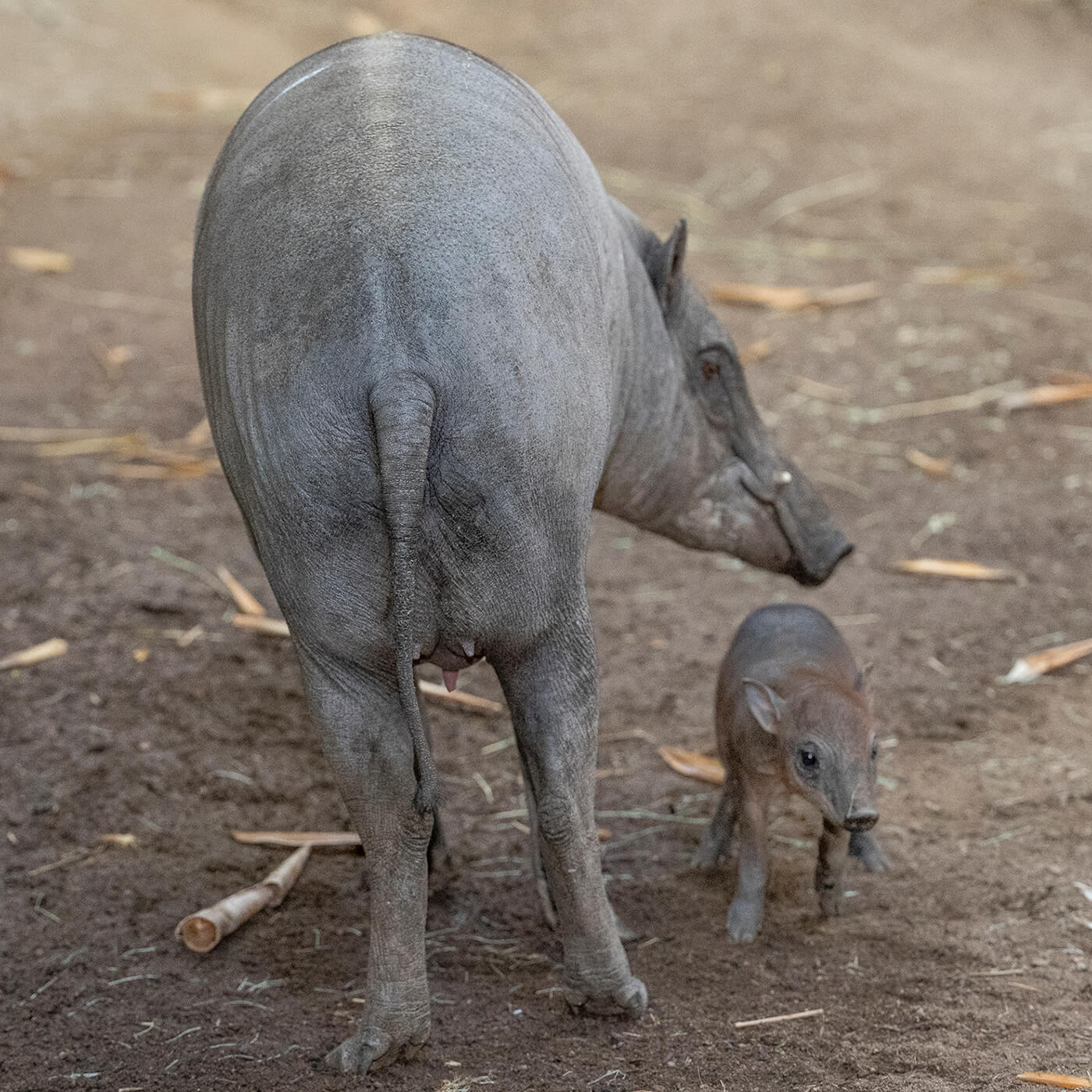
BRINGING UP BABY
Babirusa piglets are nursed by their mothers for the first six to eight months of life, and they grow up quickly. Unlike many wild swine species, babirusa piglets are born without camouflage stripes.
The Zoo’s babirusas get a variety of enrichment, including gourds with food pellets inside, Victoria said. “They’ve figured out how to push in the sides and get the pellets out.” Additional enrichment includes papier-mâché to tear through and many kinds of different scents for them to explore. “Cinnamon is a favorite, and they also like different perfumes. And they really like popcorn!” Favorite browse items include Grewia, hibiscus, and fig tree branches with figs on them.
All of the Zoo’s babirusas have learned husbandry behaviors to assist in their own care. Once a month, each of them will step on a scale, so that keepers can get their current weights. “All of them are doing great—and getting bigger,” Victoria said.
“They all have their own individual personalities,” Victoria said. “Mary-Kate and Fig are great mothers—they are so family oriented, and they are very close to their daughters.”
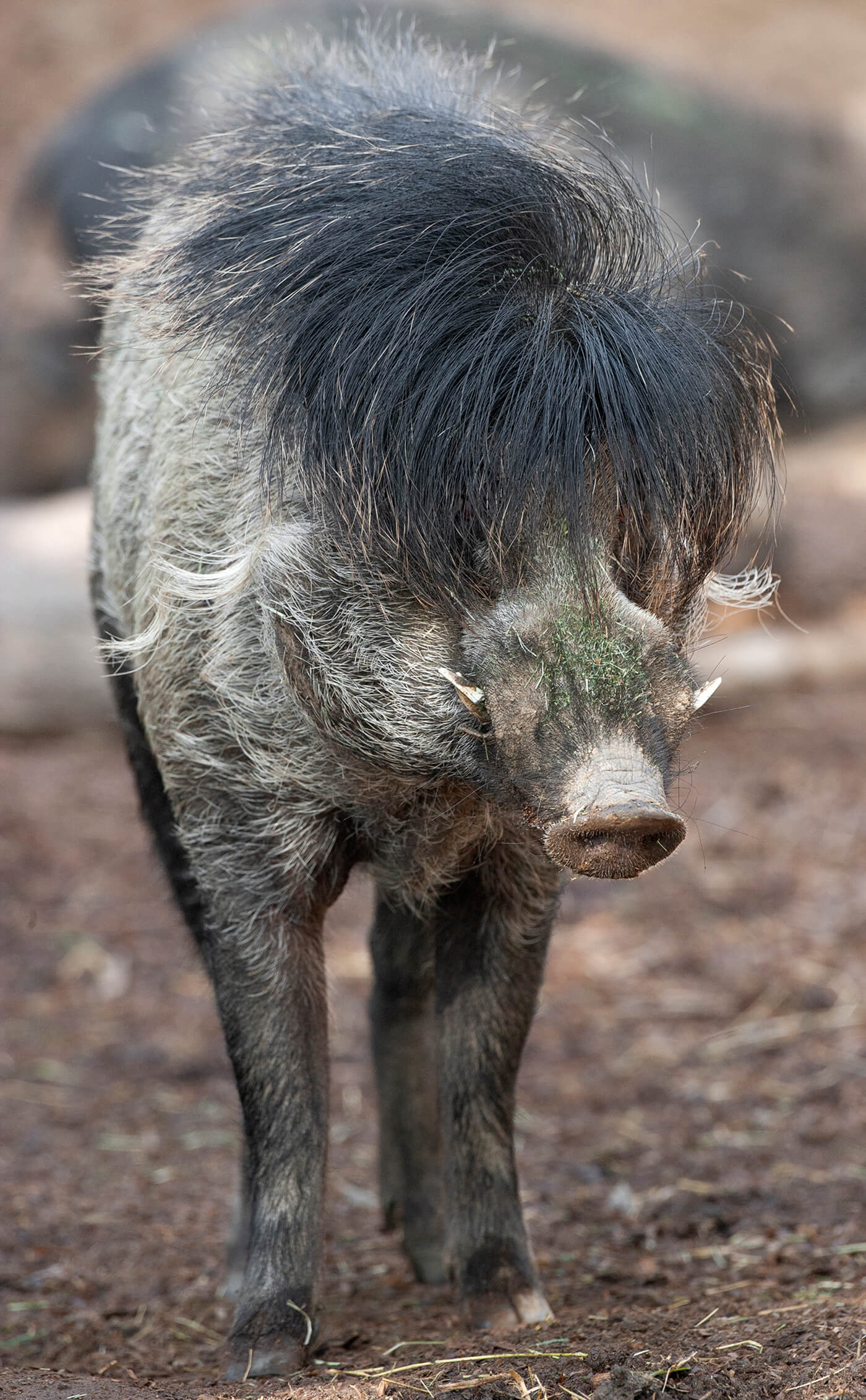
WATCH THE HAIR
During mating season, male Visayan warty pigs grow stiff, spiky hair.
Other wild swine you may see include Visayan warty pigs at the Zoo and southern warthogs at the Safari Park. Native to the Philippines, Visayan warty pigs are Critically Endangered—and the San Diego Zoo was the first Zoo outside their homeland to breed them, in an effort to boost their numbers. Visayan warty pig boars have three pairs of fleshy bumps, or “warts,” on their face, which can help protect them from the tusks of a rival in a fight. Boars grow stiff, spiky hair during mating season.
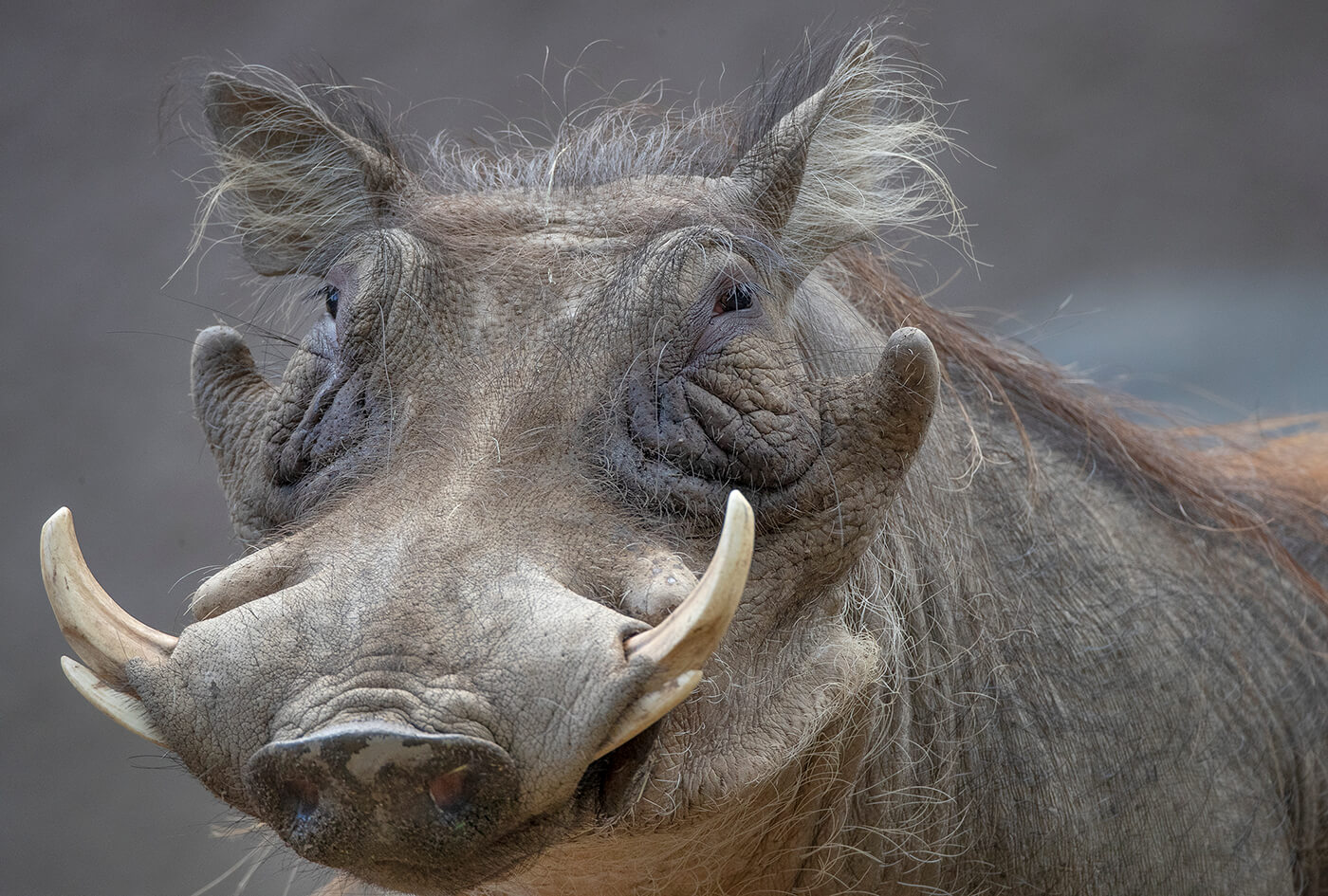
THEY’RE NOT REALLY WARTS
The pads of thick, wrinkled skin on the face of a southern warthog provide added protection for males when they are fighting for mates.
Southern warthogs—found in savanna, woodlands, and grasslands from north central to southern Africa—also have thick “warty” protective pads of skin on their face. However, this wild swine species is much larger: males can weigh up to 250 pounds (in contrast to the 88-pound Visayan warty pig male). Southern warthogs also have larger tusks. You can see southern warthogs Orkima and Stuart at the Safari Park’s African Outpost, along with their four growing offspring, born in July 2018.
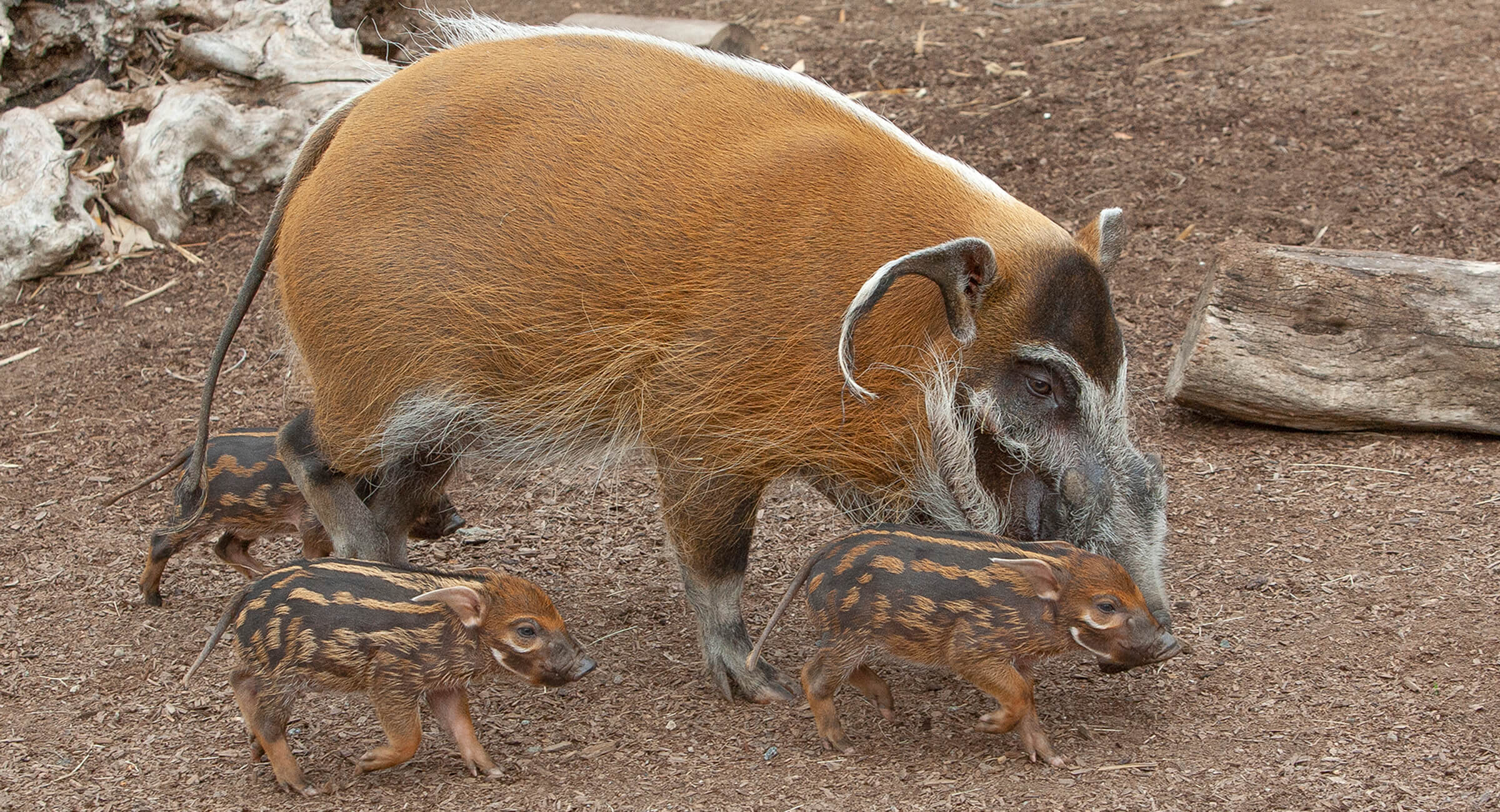
Don’t Get Too Close
Pigs may be smart, social (with each other), and communicative, but they are also very protective of their young and their home areas. “People need to know that they shouldn’t approach wild pigs,” Stacey said. “Males have large tusks, and both males and females are quick to defend their territory.”
They have good reason to be defensive: the biggest threats wild swine species face in their native habitats are hunting by humans and a variety of predators, including big cats, hyenas, and even pythons. And as more wild swine habitat is being converted to agriculture each year, the animals face threats from farmers trying to protect their crops.
According to the Shengxiao, or lunar zodiac, those born during the Year of the Pig share a variety of character traits that ancient astrologists attributed to pigs, including bravery, intelligence, diligence, amiability, sincerity, and an easygoing nature. Whether or not that is true, pigs are indeed remarkable creatures. You can learn more about species of wild swine—and their actual traits—at the Zoo and Safari Park.

